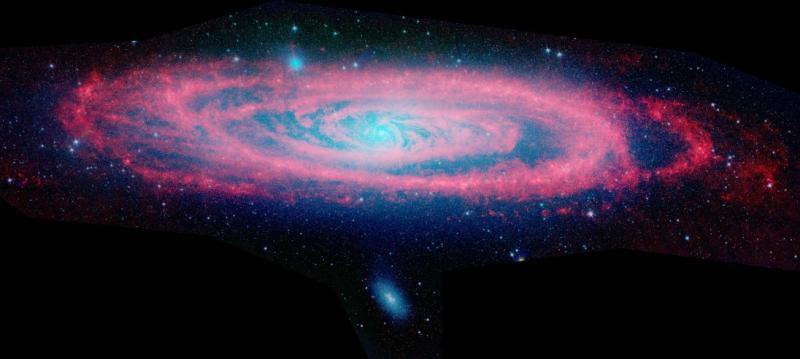
|
Explanation: This wide, detailed Spitzer Space Telescope view features infrared light from dust (red) and old stars (blue) in Andromeda, a massive spiral galaxy a mere 2.5 million light-years away. In fact, with over twice the diameter of our own Milky Way, Andromeda is the largest nearby galaxy. Andromeda's population of bright young stars define its sweeping spiral arms in visible light images, but here the infrared view clearly follows the lumpy dust lanes heated by the young stars as they wind even closer to the galaxy's core. Constructed to explore Andromeda's infrared brightness and stellar populations, the full mosaic image is composed of about 3,000 individual frames. Two smaller companion galaxies, NGC 205 (below) and M32 (above) are also included in the combined fields. The data confirm that Andromeda (aka M31) houses around 1 trillion stars, compared to 4 hundred billion for the Milky Way.
|
January February March April May June July August September October November December |
| ||||||||||||||||||||||||||||||||||||||||||||||||
NASA Web Site Statements, Warnings, and Disclaimers
NASA Official: Jay Norris. Specific rights apply.
A service of: LHEA at NASA / GSFC
& Michigan Tech. U.
Based on Astronomy Picture
Of the Day
Publications with keywords: infrared - spiral galaxy - dust - Andromeda galaxy
Publications with words: infrared - spiral galaxy - dust - Andromeda galaxy
See also:
- Portrait of NGC 1055
- APOD: 2025 September 4 B NGC 4565: Galaxy on Edge
- APOD: 2025 August 28 B Galaxies, Stars, and Dust
- APOD: 2025 August 22 B A Tale of Two Nebulae
- APOD: 2025 August 19 B Giant Galaxies in Pavo
- APOD: 2025 August 18 B NGC 1309: A Useful Spiral Galaxy
- APOD: 2025 July 4 B NGC 6946 and NGC 6939
